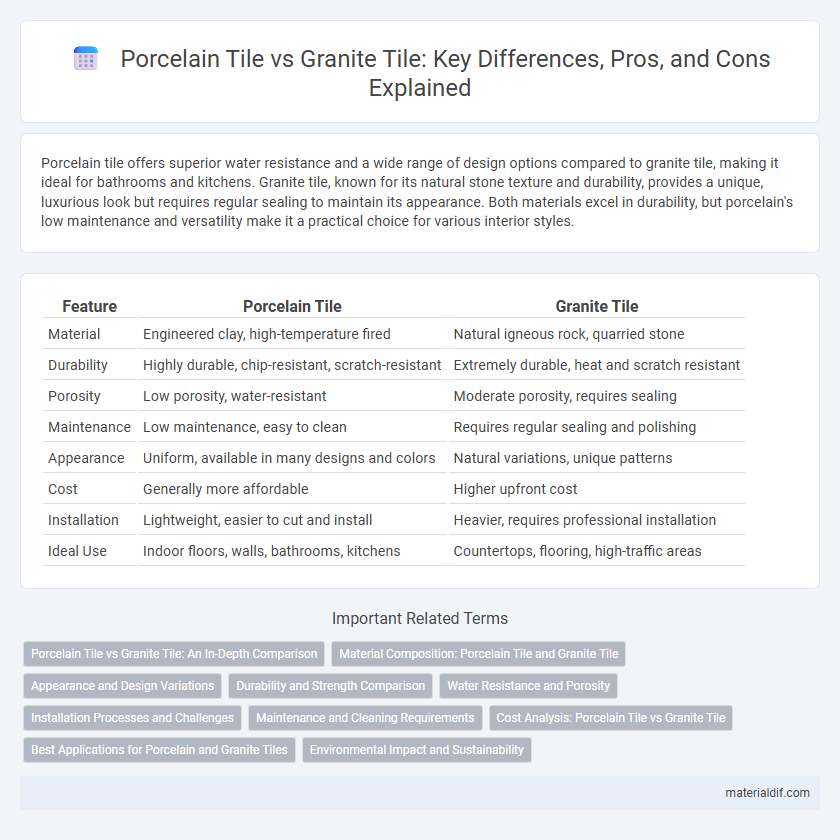Porcelain tile offers superior water resistance and a wide range of design options compared to granite tile, making it ideal for bathrooms and kitchens. Granite tile, known for its natural stone texture and durability, provides a unique, luxurious look but requires regular sealing to maintain its appearance. Both materials excel in durability, but porcelain's low maintenance and versatility make it a practical choice for various interior styles.
Table of Comparison
| Feature | Porcelain Tile | Granite Tile |
|---|---|---|
| Material | Engineered clay, high-temperature fired | Natural igneous rock, quarried stone |
| Durability | Highly durable, chip-resistant, scratch-resistant | Extremely durable, heat and scratch resistant |
| Porosity | Low porosity, water-resistant | Moderate porosity, requires sealing |
| Maintenance | Low maintenance, easy to clean | Requires regular sealing and polishing |
| Appearance | Uniform, available in many designs and colors | Natural variations, unique patterns |
| Cost | Generally more affordable | Higher upfront cost |
| Installation | Lightweight, easier to cut and install | Heavier, requires professional installation |
| Ideal Use | Indoor floors, walls, bathrooms, kitchens | Countertops, flooring, high-traffic areas |
Porcelain Tile vs Granite Tile: An In-Depth Comparison
Porcelain tile offers superior water absorption rates below 0.5%, making it highly resistant to moisture and staining compared to granite tile, which can be more porous and require sealing. Porcelain tiles are engineered from refined clay fired at higher temperatures, resulting in a denser, more durable surface that withstands heavy traffic and impacts better than natural granite, which is susceptible to scratches and chipping. Maintenance for porcelain tiles is low, requiring simple cleaning with mild detergents, whereas granite tiles demand periodic sealing to preserve their natural luster and prevent discoloration.
Material Composition: Porcelain Tile and Granite Tile
Porcelain tile is composed primarily of fine-grained clay that is fired at extremely high temperatures, resulting in a dense, non-porous surface ideal for moisture resistance. Granite tile is a natural stone formed from interlocking mineral crystals, mainly quartz, feldspar, and mica, offering strong durability and unique, natural patterns. The differences in material composition influence their performance, with porcelain providing uniformity and stain resistance, while granite offers natural beauty and superior hardness.
Appearance and Design Variations
Porcelain tiles offer a wide range of appearance options, including smooth matte, polished, and textured finishes that mimic natural stone, wood, and concrete, providing versatile design variations for any space. Granite tiles feature unique, naturally occurring patterns with granular mineral textures and a polished sheen, creating a luxurious and authentic stone look that varies from tile to tile. Porcelain's consistent color and pattern options make it ideal for modern, uniform designs, while granite's natural variations enhance traditional and rustic aesthetics.
Durability and Strength Comparison
Porcelain tile offers superior hardness and resistance to scratches compared to granite tile, making it ideal for high-traffic areas and heavy-use environments. Porcelain's low porosity enhances its durability by preventing water absorption and reducing the risk of stains, unlike granite which requires sealing to maintain its strength. Both materials provide resilience, but porcelain's consistent composition and manufacturing process yield greater long-term strength and lower maintenance needs.
Water Resistance and Porosity
Porcelain tiles exhibit exceptionally low porosity rates, typically below 0.5%, making them highly water-resistant and ideal for areas prone to moisture. In contrast, granite tiles have higher porosity levels, ranging from 0.2% to 4%, which can compromise their water resistance if not properly sealed. The superior impermeability of porcelain ensures minimal water absorption and better durability in wet environments compared to granite.
Installation Processes and Challenges
Porcelain tile installation demands precise cutting tools and a moisture-resistant adhesive due to its dense, non-porous nature, which can make adjustments challenging during placement. Granite tile requires careful sealing before installation to prevent staining and often needs a professional to handle its heavy weight and natural surface irregularities. Both materials necessitate a level subfloor, but granite's natural variation can complicate achieving a perfectly even surface compared to the uniformity of porcelain tiles.
Maintenance and Cleaning Requirements
Porcelain tiles require minimal maintenance due to their non-porous surface, resisting stains and moisture without the need for sealing, making cleaning quick with just mild detergents and water. Granite tiles, being natural stone, demand regular sealing to prevent staining and require specialized stone cleaners to maintain their polished appearance. Both materials need routine sweeping or vacuuming to remove debris, but porcelain offers greater ease and durability in daily cleaning compared to granite's more intensive upkeep.
Cost Analysis: Porcelain Tile vs Granite Tile
Porcelain tile generally costs between $3 to $10 per square foot, making it a more budget-friendly option compared to granite tile, which ranges from $5 to $15 per square foot. Installation expenses for porcelain tend to be lower due to its lighter weight and easier cutting process, while granite requires specialized tools and labor. Long-term maintenance costs favor porcelain tiles because they are more resistant to stains and scratches, reducing the need for frequent sealing or repairs often associated with granite surfaces.
Best Applications for Porcelain and Granite Tiles
Porcelain tiles excel in high-moisture areas like bathrooms and kitchens due to their low porosity and stain resistance, making them ideal for flooring, backsplashes, and wall cladding. Granite tiles, known for their natural beauty and durability, are best suited for countertops, outdoor patios, and high-traffic spaces requiring scratch and heat resistance. Both materials offer versatility, but porcelain's maintenance ease favors indoor applications, while granite provides longevity and elegance in both indoor and outdoor environments.
Environmental Impact and Sustainability
Porcelain tiles have a lower environmental impact than granite tiles due to their energy-efficient manufacturing process and use of abundant raw materials like clay and feldspar. Porcelain's non-porous surface requires less sealing and maintenance, reducing chemical use over its lifespan, while granite quarrying involves significant ecosystem disruption and higher carbon emissions. Recyclability of porcelain tiles further enhances their sustainability compared to granite, which is less commonly recycled and often discarded as waste.
Porcelain Tile vs Granite Tile Infographic

 materialdif.com
materialdif.com